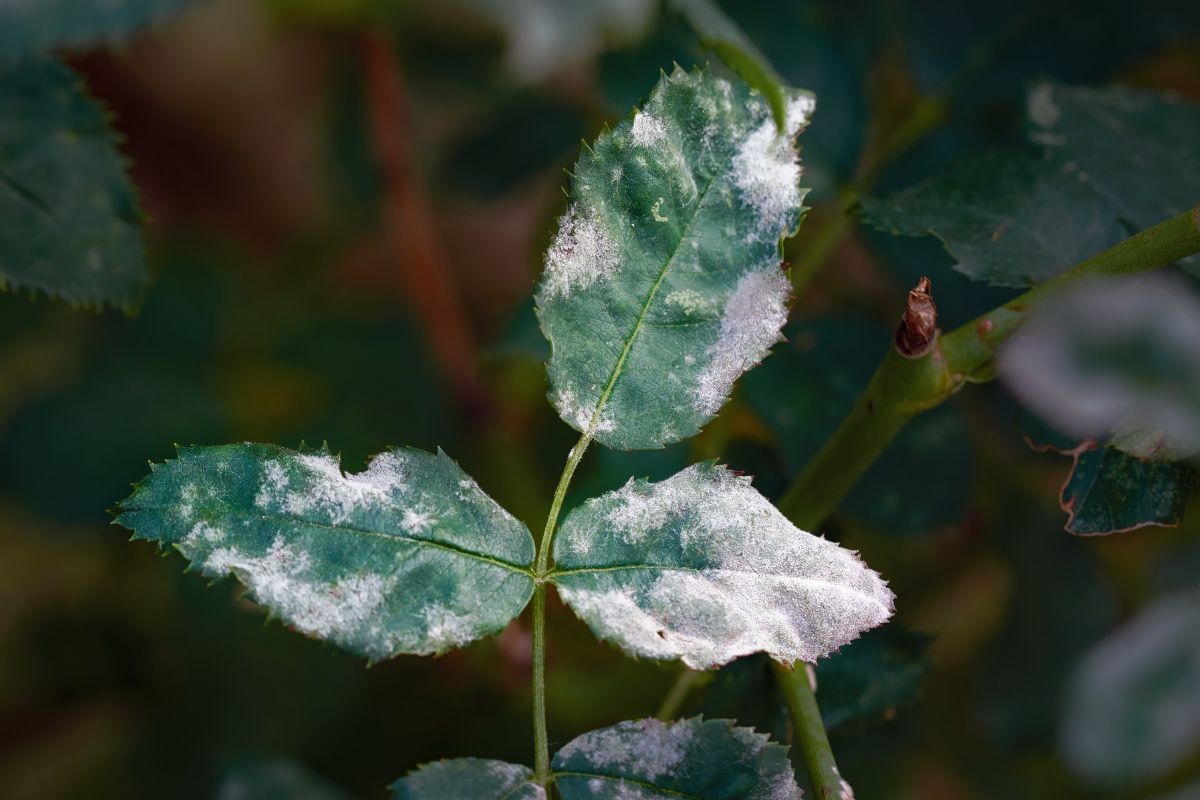
The Problem with Powdery Mildew
If you see vegetation that looks like it’s sprinkled with baby powder or covered in cobwebs, chances are you’re seeing powdery mildew. This disease is highly infectious, and while you may not see signs of it now, it poses a constant threat to your plants.
Fruits, vegetables, and berries are susceptible, along with trees and vining plants like tomatoes and grapes. Popular flowers, including some varieties of zinnia, roses, phlox, bee balm, and peony, can all fall prey to powdery mildew infections.
This common, widespread disease can develop anytime during the growing season but powdery mildew doesn’t hibernate in the colder months. It survives winter weather by attaching to plant parts and debris, leaves and twigs, and hiding in the buds of infected plants. When the temperatures rise, spores are released and spread the infection – which is why treating your crops and gardens now can help prevent a severe outbreak in the spring.
Read on to find out more about what causes powdery mildew, how it spreads and harms plants, and how to effectively treat it without damaging the environment.
What is Powdery Mildew?
A common fungal disease in the Erysiphales family, multiple species of powdery mildew affect more than 10,000 annual and perennial plants. Some varieties impact just one or two plant types while others attack a wide range of vegetation, but all types of powdery mildew require live tissue to grow and reproduce.
This fungus can thwart plant growth, limit blooms, impact photosynthesis, and reduce winter hardiness. The leaves of a newly infected plant may appear as irregular, chlorotic, or have purple areas, with powdery blotches or felt-like mats before the identifiable white, powdery appearance develops. Young leaves infected by the fungus may develop scab-like lesions and become twisted as they grow, and severely infected leaves can turn yellow and fall off. When the mold infects the buds of woody species like crepe myrtle, sycamore, and fruit trees, the trunks may grow distorted.
The disease takes a more impactful toll on crops, reducing yield and quality, damaging high-value plants, and affecting the appearance and taste of produce grown from infected hosts. As a result of the damage it causes, growers may plant crops differently to manage powdery mildew infections.
Powdery mildew is not considered a danger to most people, although directly touching it or eating an infected plant may cause allergic reactions like sneezing and coughing. Those who are most vulnerable may experience more severe breathing difficulties after direct contact with the fungus.
What is the Lifecycle of Powdery Mildew?
Powdery mildew is challenging to manage due to its unique structure and year-round lifecycle that enable it to survive all weather conditions.
The cycle starts with small, dark, and thick-walled structures called cleisthothecia that protect the fungus against cold temperatures. The cleisthothecia produce cylindrical spores called conidia that lie dormant until warm weather arrives. When conditions are right, the cleisthothecia release the conidia, which transmit the fungus to host plants.
Once vegetation is infected, mycelium appears on the leaf surface.These small fungal threads may look like fuzzy spots and can merge with spores to coat the whole leaf, sometimes covering the length of the plant. After the fungus is established, the mycelium creates new pin head-sized cleisthothecia structures, which then release more conidia and start the cycle once again.
Powdery mildew can survive environments that would kill most other fungi. For example, this disease tolerates warm, dry conditions, as well as the humid environments preferred by other types of fungal diseases. Some fungi require water on plant leaves to grow (think, foliage that is damp with rain drops or dew) but powdery mildew doesn’t require surface moisture as part of its lifecycle.
How Does Powdery Mildew Spread?
The really challenging part of powdery mildew is how easily it spreads. Carried by wind currents and spread through water or raindrops that splash onto a neighboring plant, this disease is unstoppable.
The right combination of light, weather, and ventilation provide the ideal growing conditions for this fungus to rapidly infect plant leaves and stems. Powdery mildew grows best on foliage planted in shady areas with poor air circulation, and produces more spores in higher humidity environments. Because it disperses more spores as the humidity drops, infection rates increase in spring and fall, when the days are between 70 and 80 degrees and the nights are humid. Although powdery mildew can occur all season long, it does not tolerate heat well and is less common when the thermometer reaches 90 degrees and above.
Unsurprisingly, the fungus thrives indoors in humid greenhouses where plants are in close proximity. Outdoors, the wind can carry fungal spores hundreds of miles and impact vegetation that is nowhere near the infected host plant. Once a spore lands on a new host, it quickly germinates and starts a new infection—sometimes in as little as 48 hours.
Why Conventional Fungicides are Not the Answer
Beyond damaging soil health, affecting nearby water sources like streams and rivers, and killing beneficial insects like bees, butterflies, and ladybugs, conventional fungicides have been proven to be dangerous to people, pets, and the wildlife that feed on treated plants.
Despite several strains of this mold developing treatment resistance, growers use both preventative and curative fungicides in the battle against powdery mildew. Both varieties contain chemicals that may be unreliable at controlling the disease and can harm the plant and/or the environment.
Copper- and sulfur-based preventative fungicides are popular options. Those that are copper based can be somewhat effective, but this fungus requires frequent reapplication. Used regularly, copper can build up in the dirt, damaging the foliage and negatively impacting the nearby soil.
Preventative mixtures that include sulfur increase the potential for hydrogen sulfide production. When applied on days with temperatures around 90 degrees, sulfur can damage the tissues of the host plant. It can also be lethal to some of the natural enemies that help control this fungus’ spread.
Powdery mildew cannot be cured but some compounds called curative fungicides, contain chemicals like acetimides, dicarboxymides, and sterol inhibitors, and are used post-infection to prevent further pathogens from developing. To be effective, they must be applied within 24 to 72 hours of the infection—which presents a challenge because signs of powdery mildew are not typically visible for several days.
Some growers use Neem oil to attempt to manage this disease but, not only has it not been proven effective, it can cause the host plant internal damage, leaf burn, and stress symptoms. Neem oil is deadly to all insects that come in contact with it, may cause stomach irritation for those who eat foods treated with it, and humans who touch it may experience skin reactions. Overusing Neem oil can lead to runoff and accumulation in waterways, negatively impacting fish and other aquatic life.
Safe Solutions to Your Powdery Mildew Problem
No matter how it is treated, powdery mildew will inevitably spread; its tenacity guarantees it. However, there are actions you can take to effectively manage this disease.
If you see signs of infection, remove the diseased parts of the plant (and throw them away versus composting) and ensure you disinfect any garden tools that may have come in contact with the fungus.
Long term actions include using Integrated Pest Management (IPM) practices, like choosing plants typically unaffected by powdery mildew, practicing crop rotation and soil management, all help. How and where you plant can make a significant difference: planting in an area with full sunlight with well-drained soil makes infection more difficult. Leaving space between plants provides more light penetration, decreases moisture, and improves air flow – reducing the humid environment in which powdery mildew thrives.
There is one additional powerful alternative to controlling powdery mildew that is successful and sustainable: GrowSafe.
GrowSafe is an effective curative treatment that works by coating a plant’s surface, forming a shield against fungi, pests, and diseases. Its oils naturally inhibit spore germination, which is why it is also used as a preventative treatment to protect plants from the invasive conidia seeking a host.
Because it’s made from biodegradable, food-grade ingredients (corn, soybean, sunflower and coconut oils and citric acid), GrowSafe is 100% safe for people, pets, and the environment. It is safe to use on all plants and it will not alter their taste or smell. Plus, it can be sprayed during any point in the growing cycle. More so, it’s completely safe for beneficial insects! For the best results, apply GrowSafe during dry conditions and reapply after it rains.
While nothing can fully eradicate powdery mildew, a combination of IPM practices and the regular use of GrowSafe can help protect your farms and gardens from this rampant fungus. Prime months to begin preventative measures are typically January, February, and March, though prevention is always better than a problem. No matter the time of year, we recommend beginning your powdery mildew management practices today.
